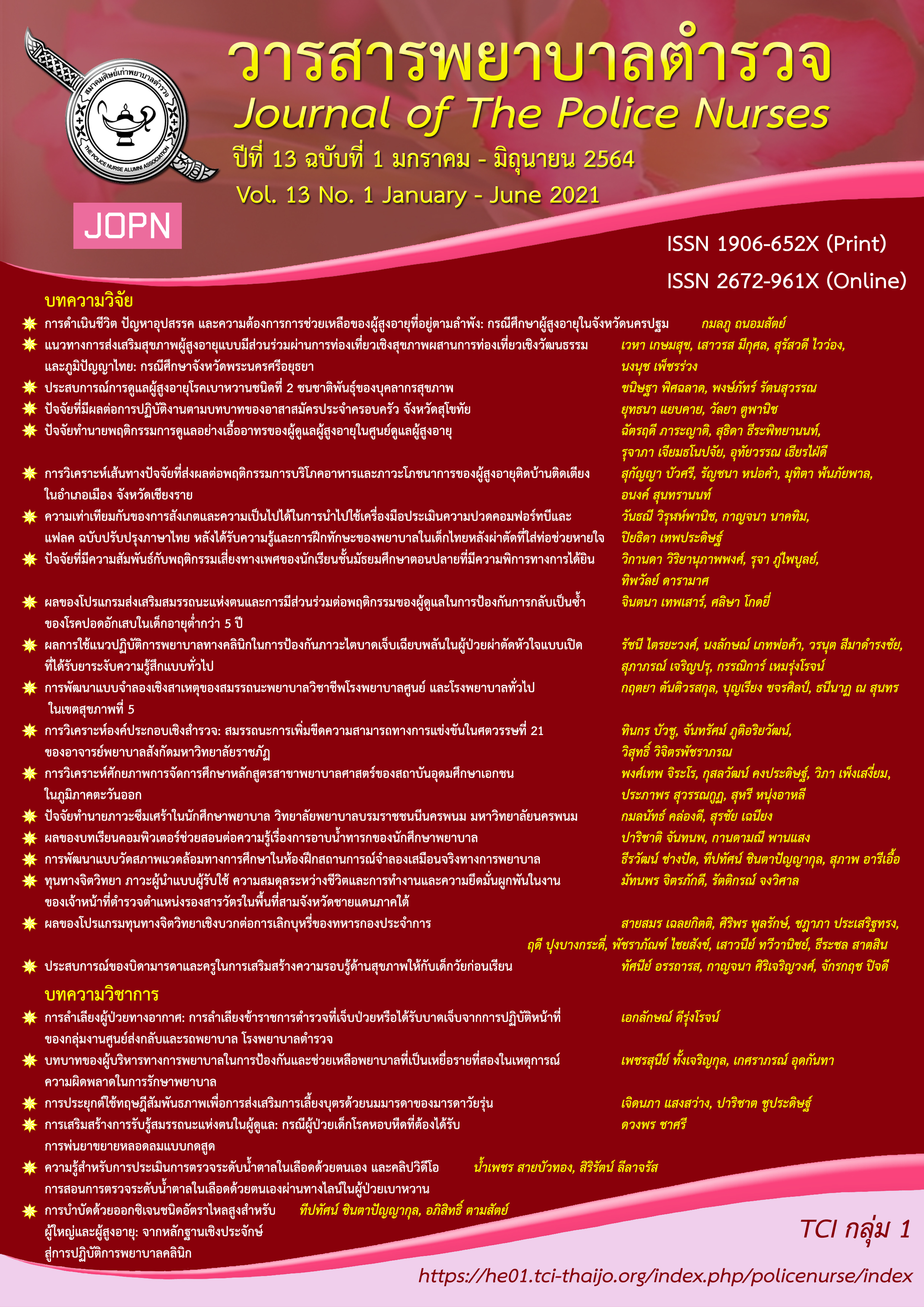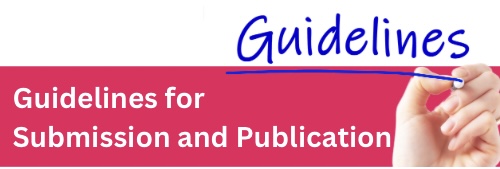The A DEVELOPMENT OF THE EDUCATIONAL ENVIRONMENT IN NURSING SIMULATION LABORATORY SCALE
Keywords:
educational environment, nursing simulation laboratory scale, scale developmentAbstract
This descriptive research aimed to develop and validate an educational environment measurement for practicing nursing simulation laboratory. The total sample was 255 students, the 3rd and 4th year of nursing students from Ramathibodi School of Nursing. The research instrument was the educational environment measurement with 5-scale rating. Data were analyzed using frequency, percentage, mean, standard deviation, Cronbach's alpha coefficient, exploratory factor analysis (EFA), and confirmatory factor analysis (CFA).
Findings demonstrated that the educational environment measurement consisted of five components: 1) perceptions of learning, 2) perceptions of teachers, 3) academic self-perceptions, 4) perceptions of atmosphere, and 5) social self-perceptions. The measurement contained 23 items with a content validity index ranging from .83 to 1.0. For reliability testing, each component’s reliability coefficient ranged from .70 to .87, with an overall reliability coefficient of .88. For construct validity testing, the exploratory factor analysis exhibited five components with the Eigen values greater than 1.0. The measurement explained 63.91% of the total variances for the educational environment in the nursing simulation laboratory. Additionally, the construct validity tested by confirmatory factor analysis revealed an empirical data confirming the use of the educational environment measurement to correctly evaluate an educational environment in nursing simulation laboratory (chi-square (df = 4, N=255) = 6.064, p = .1944, CFI = .996, TLI = .991, RMSEA = .045, SRMR = .012).
This study suggests that the developed instrument educational environment measurement is reliable and valid for assessing the teaching and learning environment in a nursing simulation laboratory.
Downloads
References
Alis, N., Jaafar, W. M. W., & Ayob, A. F. M. (2015). The reliability of "learning environment preferences" inventory in the Malaysian Context. Elixir International Journal, 78, 29769-29772.
Bridges, D. R., Davidson, R. A., Odegard, P. S., Maki, I. V., & Tomkowiak, J. (2011). Interprofessional collaboration: Three best practice models of interprofessional education. Medical education online, 16. https://doi.org/10.3402/meo.v16i0.6035
Clarke, J. A. (1990). The reliability of the college and university classroom environment inventory: Some Australian data Psychological Reports,
(3suppl), 1339–1342.
DeVellis, R. F. (2016). Scale development: Theory and applications (4th ed.) Los Angeles, CA: Sage.
Francisca, A., & Oluyemisi, A. (2007). Science laboratory environment and academic performance. Journal of Science Education and Technology, 16, 500-506.
Genn J. M. (2001). AMEE Medical Education Guide No. 23 (Part 2): Curriculum, environment, climate, quality and change in medical education - A unifying perspective. Medical teacher, 23(5), 445–454.
Hair, J., Black, W., Babin, B., & Anderson, R. (2019). Multivariate data analysis (8th ed.). Hampshire, UK: Cengage Learning.
Hsiao, C-H., Wu, Y-T., Lin, C-Y., Wong, T., W., Fu, H-H., Yeh, T-K., & Chang, C-Y. (2014). Development of an instrument for assessing senior high school students’ preferred and perceived laboratory classroom environment. Learning Environments Research, 17(3), 389-399.
Janpilom, N., Sengsri, S., & Kongmanus, K. (2018). Attitudes of nursing instructors and students towards simulation-based learning in the subject of nursing practice. Boromarajonani College of Nursing, Uttaradit Journal, 10(2), 222-233.
Kantiwong, A. A. (2011). Development of educational environment test for medical students. Royal Thai Army Medical Journal, 70(4), 229-238.
Kline, R. B. (2016). Principle and practice of structural equation modeling (4th ed.). New York, NY: Guilford Press.
Kunaviktikul, W. (2015). Teaching and learning in the discipline of nursing in the 21st century. Nursing Journal, 42(2), 153-156.
Laohapiboolrattana, W., Chatdang, V., Suntronsawat, S., Chuchuen, P., Suvarnabhumi, K., & Choosong, T. (2016). Assessment of medical student’s perceptions towards educational environment in surgical theaters. Songklanagarind Medical Journal, 34(4), 163-171.
Little, T. D., Cunningham, W. A., Shahar, G., & Widaman, K. F. (2002). To parcel or not to parcel: Exploring the question, weighing the merits. Structural Equation Modeling, 9(2), 151–173.
Meyers, C. & Jones, T. B. (2019). Promoting active learning: Strategies for the college classroom (e-book). San Francisco, CA: Jossey-Bass Inc.
Miles, S., Swift, L., & Leinster, S. J. (2012). The dundee ready education environment measure (DREEM): A review of its adoption and use. Medical teacher, 34(9), e620–e634.
Moore, K. D. (2015). Effective instructional strategies: From theory to practice. Los Angeles, CA.: SAGE.
Phothidara, Y. (2011). Nursing education management: For student generation Y. Journal of Nursing Science and Health, 34(2), 61-69.
Qin, Y., Wang, Y., & Floden, R. E. (2016). The effect of problem-based learning on improvement of the medical educational environment: A systematic review and meta-analysis. Medical principles and practice, 25(6), 525–532.
Sinthuchai, S., & Ubolwan, K. (2017). Fidelity simulation-based learning: Implementation to learning and teaching management. Journal of The Royal Thai Army Nurses, 18(1), 29-38.
Sinthuchai, S., Ubolwan, K., & Boonsin, S. (2017). Effects of high-fidelity simulation-based learning on knowledge, satisfaction, and self-confidence among the fourth year nursing students in comprehensive nursing care practicum. Ramathibodi nursing journal, 23(1), 113-127.
Wangsaturaka, D. & McAleer, S. (2008). Development of the clinical learning climate measure for undergraduate medical education. South East Asian Journal of Medical Education, 2(2), 41-51.
Downloads
Published
How to Cite
Issue
Section
License
ผลงานที่ได้ตีพิมพ์แล้วจะเป็นลิขสิทธิ์ของวารสารพยาบาลตำรวจ















